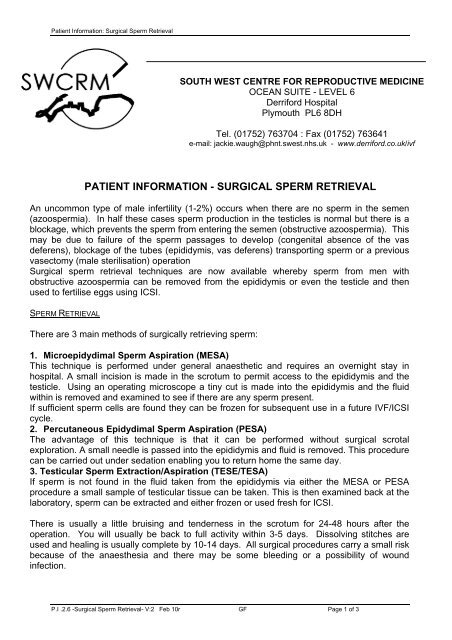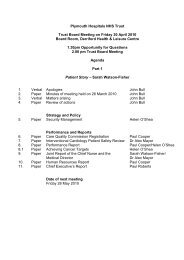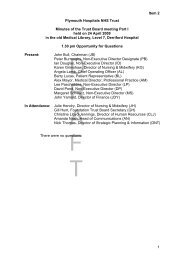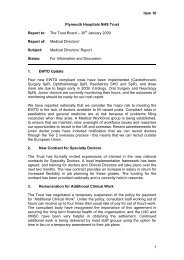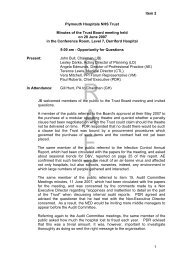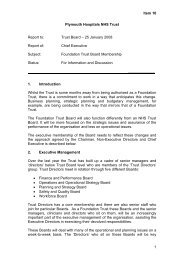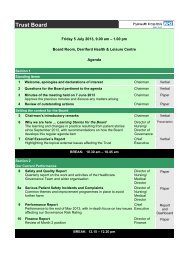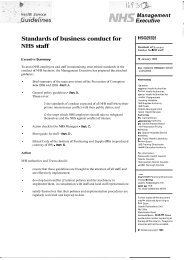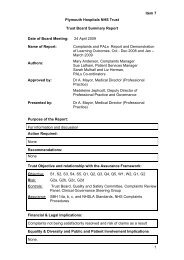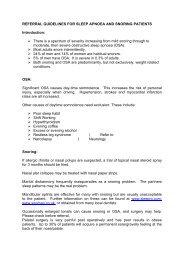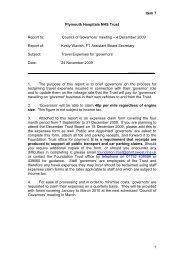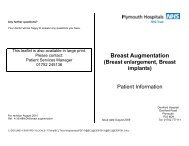patient information - surgical sperm retrieval - Plymouth Hospitals
patient information - surgical sperm retrieval - Plymouth Hospitals
patient information - surgical sperm retrieval - Plymouth Hospitals
Create successful ePaper yourself
Turn your PDF publications into a flip-book with our unique Google optimized e-Paper software.
Patient Information: Surgical Sperm Retrieval<br />
SOUTH WEST CENTRE FOR REPRODUCTIVE MEDICINE<br />
OCEAN SUITE - LEVEL 6<br />
Derriford Hospital<br />
<strong>Plymouth</strong> PL6 8DH<br />
Tel. (01752) 763704 : Fax (01752) 763641<br />
e-mail: jackie.waugh@phnt.swest.nhs.uk - www.derriford.co.uk/ivf<br />
PATIENT INFORMATION - SURGICAL SPERM RETRIEVAL<br />
An uncommon type of male infertility (1-2%) occurs when there are no <strong>sperm</strong> in the semen<br />
(azoo<strong>sperm</strong>ia). In half these cases <strong>sperm</strong> production in the testicles is normal but there is a<br />
blockage, which prevents the <strong>sperm</strong> from entering the semen (obstructive azoo<strong>sperm</strong>ia). This<br />
may be due to failure of the <strong>sperm</strong> passages to develop (congenital absence of the vas<br />
deferens), blockage of the tubes (epididymis, vas deferens) transporting <strong>sperm</strong> or a previous<br />
vasectomy (male sterilisation) operation<br />
Surgical <strong>sperm</strong> <strong>retrieval</strong> techniques are now available whereby <strong>sperm</strong> from men with<br />
obstructive azoo<strong>sperm</strong>ia can be removed from the epididymis or even the testicle and then<br />
used to fertilise eggs using ICSI.<br />
SPERM RETRIEVAL<br />
There are 3 main methods of <strong>surgical</strong>ly retrieving <strong>sperm</strong>:<br />
1. Microepidydimal Sperm Aspiration (MESA)<br />
This technique is performed under general anaesthetic and requires an overnight stay in<br />
hospital. A small incision is made in the scrotum to permit access to the epididymis and the<br />
testicle. Using an operating microscope a tiny cut is made into the epididymis and the fluid<br />
within is removed and examined to see if there are any <strong>sperm</strong> present.<br />
If sufficient <strong>sperm</strong> cells are found they can be frozen for subsequent use in a future IVF/ICSI<br />
cycle.<br />
2. Percutaneous Epidydimal Sperm Aspiration (PESA)<br />
The advantage of this technique is that it can be performed without <strong>surgical</strong> scrotal<br />
exploration. A small needle is passed into the epididymis and fluid is removed. This procedure<br />
can be carried out under sedation enabling you to return home the same day.<br />
3. Testicular Sperm Extraction/Aspiration (TESE/TESA)<br />
If <strong>sperm</strong> is not found in the fluid taken from the epididymis via either the MESA or PESA<br />
procedure a small sample of testicular tissue can be taken. This is then examined back at the<br />
laboratory, <strong>sperm</strong> can be extracted and either frozen or used fresh for ICSI.<br />
There is usually a little bruising and tenderness in the scrotum for 24-48 hours after the<br />
operation. You will usually be back to full activity within 3-5 days. Dissolving stitches are<br />
used and healing is usually complete by 10-14 days. All <strong>surgical</strong> procedures carry a small risk<br />
because of the anaesthesia and there may be some bleeding or a possibility of wound<br />
infection.<br />
P.I .2.6 -Surgical Sperm Retrieval- V:2 Feb 10r GF Page 1 of 3
Patient Information: Surgical Sperm Retrieval<br />
Advantages<br />
Disadvantages<br />
MESA<br />
PESA<br />
TESE/<br />
TESA<br />
o One study has shown fertilization<br />
rates of 78% and pregnancy rates of<br />
67%.<br />
o Samples are routinely subsequently<br />
frozen so can be used for a number<br />
of ICSI cycles.<br />
o Obtain <strong>sperm</strong> from men with<br />
irreparable epididymal obstructive<br />
problems.<br />
o A higher concentration of <strong>sperm</strong> may<br />
be yielded via MESA than PESA,<br />
however no difference in fertilization<br />
rates or pregnancy rates have been<br />
shown.<br />
o One study has shown fertilization<br />
rates of 82% and pregnancy rates<br />
of 73%.<br />
o Cost less than MESA.<br />
o Less invasive – less time in<br />
hospital.<br />
o Less risk of infection.<br />
o<br />
o<br />
o<br />
o<br />
Less scarring.<br />
Can be carried out the day before<br />
oocyte recovery and incubated<br />
overnight to be used fresh for ICSI,<br />
the surplus sample can then be<br />
frozen for future use.<br />
Provides a method of <strong>sperm</strong><br />
<strong>retrieval</strong> if no <strong>sperm</strong> is found in the<br />
epididymis.<br />
There is no difference in clinical<br />
pregnancy rate between fresh and<br />
frozen testicular samples.<br />
o General anaesthetic required – increased<br />
period in hospital.<br />
o More invasive than PESA therefore<br />
increased risk of pain etc following the<br />
procedure.<br />
o More expensive than PESA.<br />
o Higher risk of infection from open surgery<br />
o<br />
o<br />
o<br />
o<br />
o<br />
Possible failure to obtain <strong>sperm</strong>.<br />
Sometime <strong>sperm</strong> does not survive the<br />
freezing and thawing process very well and<br />
therefore a fresh <strong>sperm</strong> <strong>retrieval</strong> may be<br />
necessary on the day.<br />
May not be successful for irreparable<br />
epididymal obstruction.<br />
No <strong>sperm</strong> may be found and female partner<br />
may have undergone superovulation.<br />
Some discomfort may be felt during the<br />
procedure as done under local anaesthetic<br />
and sedation.<br />
o Potential risk of temporary or permanent<br />
injury to testicles due to open biopsy.<br />
o Risk of testicular pain and atrophy.<br />
o Decreased number of <strong>sperm</strong> usually<br />
retrieved than via MESA or PESA<br />
o Lower fertilization rate and pregnancy rates<br />
than with epidiymal <strong>sperm</strong><br />
o After initial extraction <strong>sperm</strong> motility is<br />
usually decreased, incubation for 24-48<br />
hours can increase motility prior to freezing<br />
or ICSI.<br />
THE FEMALE PARTNER’S TREATMENT<br />
Ovarian stimulation and egg collection is carried out a usually few weeks after the <strong>surgical</strong><br />
<strong>sperm</strong> <strong>retrieval</strong> procedure or the day after if a fresh sample is to be used. The eggs are<br />
fertilised by ICSI whereby a single <strong>sperm</strong> is injected into the egg. Once fertilised, the<br />
embryos are allowed to develop for 2-3 days and then transferred to the womb.<br />
CYSTIC FIBROSIS SCREENING IN CONGENITAL ABSENCE OF THE VAS DEFERENS<br />
Two thirds of men with absent vas deferens are carriers of the recessive gene for cystic<br />
fibrosis (CF), an illness leading to severe respiratory problems for infants. It is advised that<br />
the men have a test for the CF gene before a MESA is carried out. If found to be positive, it is<br />
recommended that the female partner has her CF status checked as well. If your partner is<br />
P.I .2.6 -Surgical Sperm Retrieval- V:2 Feb 10r GF Page 2 of 3
Patient Information: Surgical Sperm Retrieval<br />
also found to be positive for this gene we recommend full Genetic Counselling and discussion<br />
prior to considering treatment.<br />
Surgical <strong>sperm</strong> <strong>retrieval</strong> procedures do not guarantee that <strong>sperm</strong> will be found.<br />
Survival of any <strong>sperm</strong> that is retrieved during the procedure after freezing and thawing<br />
also cannot be guaranteed.<br />
ALTERNATIVES TO SURGICAL SPERM RETRIEVAL<br />
As an alternative to <strong>surgical</strong> <strong>sperm</strong> <strong>retrieval</strong> donor <strong>sperm</strong> can be used for insemination.<br />
However there is currently a national shortage of donor <strong>sperm</strong> within the UK. Please see PI<br />
2.1 for <strong>information</strong> on donor insemination.<br />
Y CHROMOSOME SCREENING IN PATIENTS WITH AZOOSPERMIA<br />
In some <strong>patient</strong>s who do not have some <strong>sperm</strong> in their ejaculate the cause may be due to<br />
micro deletion of part of their Y chromosome. If <strong>sperm</strong> from such a <strong>patient</strong> is used to achieve<br />
a pregnancy any male child will carry the same deletion.<br />
References:<br />
Lin YM, Hsu CC, Kuo TC, Lin JS, Wang ST, Huang KE (2000). Journal of the Formosan<br />
medical association. Percutaneous epididymal <strong>sperm</strong> aspiration versus micro<strong>surgical</strong><br />
epidydimal <strong>sperm</strong> aspiration for irreparable obstructive azoo<strong>sperm</strong>ia - experience with 100<br />
cases.<br />
Rosenlund B, Westlander G, Wood M, Lundin K, Reismer E, Hillensjo T (1998). Human<br />
Reproduction 13 2805-07. Sperm Retrieval and fertilization in repeated percutaneous<br />
epididymal <strong>sperm</strong> aspiration.<br />
Pasqualotto F, Rossi-Ferragut L, Rocha C, Iaconelli A, Borges E (2002). Journal of Urology<br />
167 1753-1756. Outcome of in vitro fertilization and intracytoplasmic injection of epididymal<br />
and testicular <strong>sperm</strong> obtained from <strong>patient</strong>s with obstructive and non obstructive<br />
azoo<strong>sperm</strong>ia.<br />
Kwan H, Chow V, Clark A. University of British Columbia, Vancouver, Canada.<br />
P.I .2.6 -Surgical Sperm Retrieval- V:2 Feb 10r GF Page 3 of 3


